#What is Horizontal Polarizer
Explore tagged Tumblr posts
Text
#How LCD Works#What is TFT Display#What is Vertical Polarizer#What is Horizontal Polarizer#LCD Working Principles#Liquid Crystal Display#How Mobile Display Works#Internal Structure of LCD
0 notes
Text
Alright I NEED to know the biology lore of how can ghasts live in what is basically a fire dimension with no water, that probably smells like toxic as heck (because of all the combustion), and that is basically a big cave that probably makes it a giant furnace. Heck, even the implications of how the player can stand it either.
Because if that thing thrives on water it must be a water/air amphibian (y'know, instead of land), or be able to survive with mostly carbon (because the nether is in constant combustion, there must be oxygen as well as a shit ton of CO2).
Along with the amphibian speculation some ppl think it may have slimy/soft skin, but we have seen ghasts swimming in lava or under lava waterfalls, so there must be some draconic features like hard scales that cover it up, like the lava snail could he need lots of iron or use it somewhere on its body? But also we know the nether probably has little to no iron, it's mostly gold, and quartz, but maybe, similar to mars, all the iron is found in netherrack (because of its reddish color).
So maybe it was a creature that lived close to volcanic places on the over world? Both in high places and underwater, to explain his ability to fly.
Do you think it started out as a small cephalopod that had a really light body? Or even a jellyfish?
Like, imagine if that skin was more like a jellyfish's bell, and somehow it has a high body temperature by itself, so when getting out of the water they naturally float like hot-air balloons.
So, maybe they don't live that deep underwater, or slowly evolved to live in less pressurized environments until they escaped water.
Considering they have both eyes on front and also a mouth there too, they may be closer to octopus than squids, and look more like the martians in the war of the worlds book. But not that ugly.
Maybe the ghast is a giant octopus that is horizontal like a cuttlefish. And what if it also lost the ability to camouflage? And that's why they're pale white, my headcanon is that they're actually transparentish in the way polar bear fur is transparent. And high temperature environments made them lose their color changing skills because their skin had a higher priority of becoming harder?
Along with the volcanic thing maybe they can stand the nether because they need lots of minerals to thrive? And the nether is basically an infinite cave. Now I need to know how pressurized is the deep ocean and also if the nether has a high or low pressure too, and if that's the case how could a ghast withstand the shift from there to floating in the over world?
Of the ghast was or used to be an over world creature how did the interdimentional migration work? Were they brought there because of commerce? As transportation? (In the Minecraft movie we see the piglins using it to fly), if they are highly adapted to the nether that means they must have been there for a long time, but also we know nether portals are made by intelligent creatures like us or the piglins, so it could have happened more than 50,000 years ago or even a million if that's the case, since homo erectus or before?, or are there rare instances of natural portals occurring?
What of the ghast is like those creatures that live exclusively on a specific part or island on earth and can't be found anywhere else? And a natural portal occurred and then a constant swapping led them to getting trapped there or something forced them to, like a predator? Although I don't think the over world has anything that Could be threatening to them, not even the warden since they can fly.
Or maybe they ARE nether creatures, and the ancient nether was way different, maybe even colder, and more humid. We know we can't place water there, but we can have cauldrons, also, the presence of life and fungi there must be a sign that there must be a kind of humidity somehow, maybe not water by now, maybe a different liquid.
AAAAAAAAAAAAAAAAAAAAAAAAAAAAAAAAA there's so many interesting stuff to speculate about this creature and maybe I'm going a bit too nerdly but that new addition alone was THAT good to the game, can't wait to befriend a ghast myself.
#ghast#Minecraft#ghastling#minecraft live#minecraft live 2025#the nether#biology#worldbuilding#speculative biology#fantasy#science fiction#sci fi
60 notes
·
View notes
Note
Do you have any neat calcites?
Do I ever!! Here are just a few of my favorites.
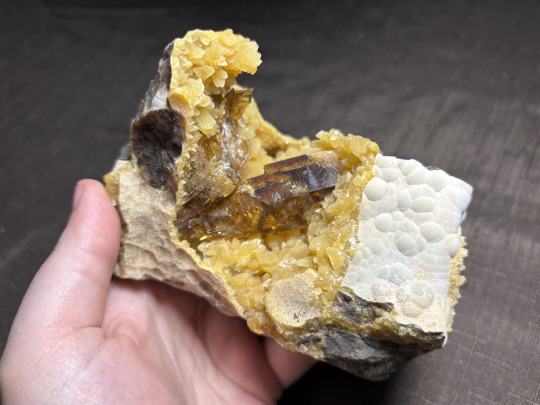
Here’s a specimen of huge brown barite crystals on a druzy of yellow calcite, from Elk Creek South Dakota.
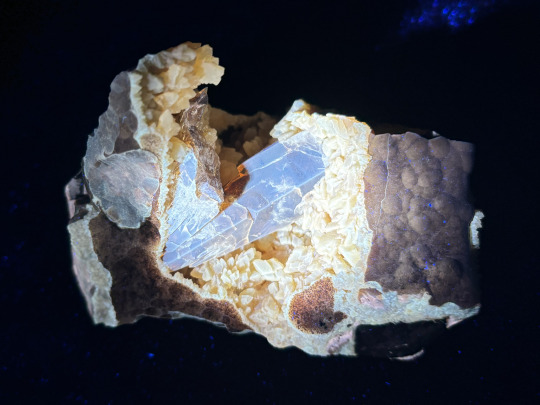
Under a long wave UV light (365nm), the calcite fluoresces yellow, and the barite fluoresces pale blue.
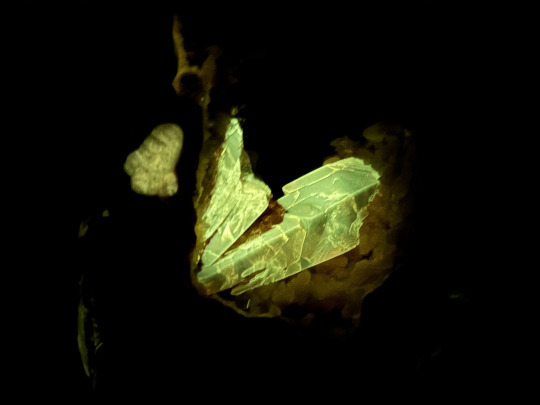
The barite also has very strong yellow-green phosphorescence, meaning it glows in the dark for a while after the UV light is removed!

This is mangano calcite, a form of calcite that gets its faint pink color from manganese.

This specimen features lenticular crystals and a cool “pagoda” formation!
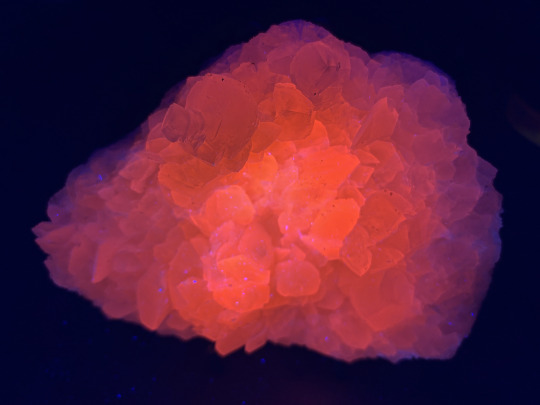
And of course, here it is showing off what mangano calcite is most famous for: its gorgeous orange-pink fluorescence.
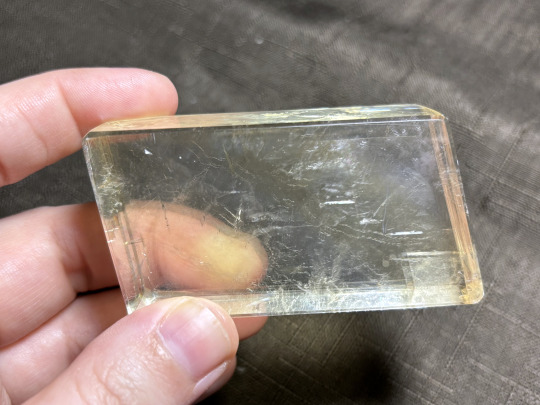
Here is some classic optical calcite! Although it’s often called "Iceland Spar", this particular specimen is from Mexico.

Optical calcite is known for its birefringence, an optical effect in which it doubles the image behind it! This is because calcite’s crystal structure polarizes the light passing through it, splitting it into horizontal and vertical wavelengths. All calcite technically does this; we can just see it happening in optical calcite because it is very clear and easy to see through.

This beautiful, water-clear specimen of dogstooth calcite crystals is from Linwood Mine in Iowa. It features very distinct phantoms!

Phantoms form when a thin layer of some other mineral begins growing on the surface of the crystal. As the calcite continues to grow, that layer becomes trapped inside of the crystal, becoming a faint record of the crystal’s size and shape when it was much younger! Calcite phantoms are especially interesting because their image is distorted by birefringence.

This piece is a columnar calcite from Fujian Provence, China! Note the uncommon column shapes of the crystals.
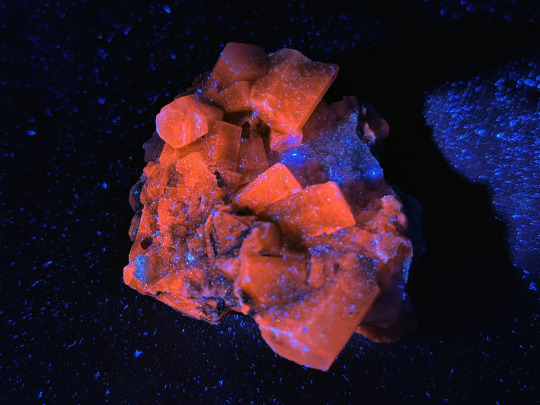
It fluoresces a lovely orange red!

And of course my favorite calcite of all! This specimen is cobaltocalcite from Morocco. While that hot pink color looks totally dyed and fake, it’s actually completely natural! Cobaltocalcite gets its distinctive color from atoms of cobalt in its molecular structure.
There's more calcite in my collection, but these are the best, I think!
348 notes
·
View notes
Text
What it meant to "do geology" in Hutton's time was to apply lessons of textual hermeneutics usually reserved for scripture [...] to the landscape. Geology was itself textual. Rocks were marks made by invisible processes that could be deciphered. Doing geology was a kind of reading, then, which existed in a dialectical relationship with writing. In The Theory of the Earth from 1788, Hutton wrote a new history of the earth as a [...] system [...]. Only a few kilometers away from Hutton’s unconformity [the geological site at Isle of Arran in Scotland that inspired his writing], [...] stands the remains of the Shell bitumen refinery [closed since 1986] as it sinks into the Atlantic Ocean. [...] As Hutton thought, being in a place is a hermeneutic practice. [...] [T]he Shell refinery at Ardrossan is a ruin of that machine, one whose great material derangements have defined the world since Hutton. [...]
The Shell Transport and Trading Company [now the well-known global oil company] was created in the Netherlands East Indies in 1897. The company’s first oil wells and refineries were in east Borneo [...]. The oil was taken by puncturing wells into subterranean deposits of a Bornean or Sumatran landscape, and then transported into an ever-expanding global network of oil depots at ports [...] at Singapore, then Chennai, and through the Suez Canal and into the Mediterranean. [...] The oil in these networks were Bornean and Sumatran landscapes on the move. Combustion engines burnt those landscapes. Machinery was lubricated by them. They illuminated the night as candlelight. [...] The Dutch East Indies was the new land of untapped promise in that multi-polar world of capitalist competition. British and Dutch colonial prospectors scoured the forests, rivers, and coasts of Borneo [...]. Marcus Samuel, the British founder of the Shell Transport and Trading Company, as his biographer [...] put it, was “mesmerized by oil, and by the vision of commanding oil all along the line from production to distribution, from the bowels of the earth to the laps of the Orient.” [...]
---
Shell emerged from a Victorian era fascination with shells.
In the 1830s, Marcus Samuel Sr. created a seashell import business in Houndsditch, London. The shells were used for decorating the covers of curio boxes. Sometimes, the boxes also contained miniature sculptures, also made from shells, of food and foliage, hybridizing oceanic and terrestrial life forms. Wealthy shell enthusiasts would sometimes apply shells to grottos attached to their houses. As British merchant vessels expanded into east Asia after the dissolution of the East India Company’s monopoly on trade in 1833, and the establishment of ports at Singapore and Hong Kong in 1824 and 1842, the import of exotic shells expanded.
Seashells from east Asia represented the oceanic expanse of British imperialism and a way to bring distant places near, not only the horizontal networks of the empire but also its oceanic depths.
---
The fashion for shells was also about telling new histories. The presence of shells, the pecten, or scallop, was a familiar bivalve icon in cultures on the northern edge of the Mediterranean. Aphrodite, for example, was said to have emerged from a scallop shell. Minerva was associated with scallops. Niches in public buildings and fountains in the Roman empire often contained scallop motifs. St. James, the patron saint of Spain, was represented by a scallop shell [...]. The pecten motif circulated throughout medieval European coats of arms, even in Britain. In 1898, when the Gallery of Palaeontology, Comparative Anatomy, and Anthropology was opened in Paris’s Museum of Natural History - only two years after the first test well was drilled in Borneo at the Black Spot - the building’s architect, Ferdinand Dutert, ornamented the entrance with pecten shell reliefs. In effect, Dutert designed the building so that one entered through scallop shells and into the galleries where George Cuvier’s vision of the evolution of life forms was displayed [...]. But it was also a symbol for the transition between an aquatic form of life and terrestrial animals. Perhaps it is apposite that the scallop is structured by a hinge which allows its two valves to rotate. [...] Pectens also thrive in the between space of shallow coastal waters that connects land with the depths of the ocean. [...] They flourish in architectural imagery, in the mind, and as the logo of one of the largest ever fossil fuel companies. [...]
---
In the 1890s, Marcus Samuel Jr. transitioned from his father’s business selling imported seashells to petroleum.
When he adopted the name Shell Transport and Trading Company in 1897, Samuel would likely have known that the natural history of bivalves was entwined with the natural history of fossil fuels. Bivalves underwent an impressive period of diversification in the Carboniferous period, a period that was first named by William Conybeare and William Phillips in 1822 to identify coal bearing strata. In other words, the same period in earth’s history that produced the Black Spot that Samuel’s engineers were seeking to extract from Dayak land was also the period that produced the pecten shells that he named his company after. Even the black fossilized leaves that miners regularly encountered in coal seams sometimes contained fossilized bivalve shells.
The Shell logo was a materialized cosmology, or [...] a cosmogram.
Cosmograms are objects that attempt to represent the order of the cosmos; they are snapshots of what is. The pecten’s effectiveness as a cosmogram was its pivot, to hinge, between spaces and times: it brought the deep history of the earth into the present; the Black Spot with Mediterranean imaginaries of the bivalve; the subterranean space of liquid oil with the surface. The history of the earth was made legible as an energetic, even a pyrotechnical force. The pecten represented fire, illumination, and certainly, power. [...] If coal required tunnelling, smashing, and breaking the ground, petroleum was piped liquid that streamed through a drilled hole. [...] In 1899, Samuel presented a paper to the Society of Arts in which he outlined his vision of “liquid fuel.” [...] Ardrossan is a ruin of that fantasy of a free flowing fossil fuel world. [...] At Ardrossan, that liquid cosmology is disintegrating.
---
All text above by: Adam Bobbette. "Shells and Shell". e-flux Architecture (Accumulation series). November 2023. At: e-flux dot com slash architecture/accumulation/553455/shells-and-shell/ [Bold emphasis and some paragraph breaks/contractions added by me. Presented here for commentary, teaching, criticisms purposes.]
140 notes
·
View notes
Text

@sunlaire I am so sorry to get back to you so late - Was quite busy today but wanted to see if I could help you on your last point regarding the furnace for the heating system and this was too much for a comment so...
In HMS Terror it is stated a heating system was placed in Terror's orlop during Terror's retrofitting stage (1835) while they were preparing her for polar voyages,
'...A novel addition was a hot water heating system fueled by a massive furnace in the orlop deck...'
From what I can understand, this design changed:
'In 1839 this [Perkins forced hot water furnace] was replaced with a Sylvester's patent furnace...'
It is stated that the original heating system used on Terror in 1836/7 for Back's expedition 'operated so poorly once in the Arctic that Back had it dismantled.'
As for the Sylvester furnace mentioned prior and its stated position:
'The system was placed in the hold on a platform with a copper plating...'
On the updated deck plans the Sylvester furnace is noted as being placed in the hold in the Terror's hold plans, among the water tanks and ballast, essentially midship. Its rather confusing because the horizontal view of Terror's plans shows the furnace extending up into the orlop in the same position (on the orlop deck this part is 'open to beams') so I suppose you can make a case that this furnace was situated in the orlop and in the hold simultaneously and was big enough to extend (vertically) into the orlop deck. This is at least what I can deduce from squinting at the updated deck plans :D
A quick fact as well is that this heating system 'presumably' heated up just the officers cabins and the Captain's cabin. The heating for the crew accommodation spaces (such as the forecastle) were done with the galley stove.
Hope this helps and I hope you get ahold of the book itself soon!
#the terror#hms terror#mathew betts#god!! i could talk about this all day hopefully it made sense because im runnin on 3hrs sleep#i got so confused reading back but yes it seems there were two furnaces used on Terror and the first was removed after Back's expedition#the book goes into greater detail how this heating system made Back's arctic expedition much worse lol#anyway... i stop yapping now
22 notes
·
View notes
Text
Assorted Pharos/Ryoji Thoughts
So, huh, don’t expect something too meaningful or conclusive for this. It’s literally just me rambling about the possible connections and influences Pharos and Ryoji have as they come. Quite messy, and it may not make much sense…
Phallus and Birds
As I said in my post about Nyx, Pharos’ japanese name (“ファルロス”) isn’t a word that exists. It’s a portmanteau of “ファルス” (“Phallus”) and “ファロス” (“Pharos”, as in, the lighthouse of Alexandria). The two of them mark him as the masculine aspect of the Star Eater (i.e., its psyche), while its body remains as the feminine or maternal one.
“In this sense, the concept of matter is also only one archetypal representation among many others; indeed the concept of matter derives from the archetype of the Great Mother. [...] The archetype of the Father, that is, of the mind, is the polar opposite.” - Psyche and Matter, by Marie-Louise von Franz.
It's important to make clear this divide, since it harks back to one of the fundamental inspirations mentioned by the FES Fan Book: Jung’s childhood dream about “Father Phallos”. I’m not going to explain it since it’s long, but the gist is that it acted as one of the foundations of Jung’s work, as seen with Seven Sermons to the Dead:
“Spirituality conceiveth and embraceth. It is womanlike and therefore we call it mater coelestis, the celestial mother. Sexuality engendereth and createth. It is manlike, and therefore we call it phallos, the earthly father.” - Sermo V.
I'll not go into detail about what Jung exactly meant by “womanlike” or “manlike” beyond pointing out it is more akin to the Yin and Yang division, but through western or hermetic lens.
While the parts of sexuality and creativity are better represented by Ryoji for obvious reasons, the identification between Pharos and Father Phallos is still important because it points to the former’s future as the “son” or avatar of “Dea Luna Satanas”.
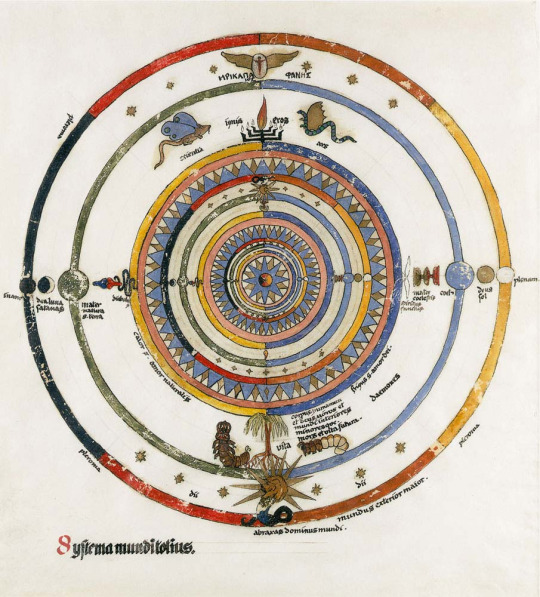
I'm putting Systema Munditotius here again because it’s a graphical summary of the cosmology and psychological principles presented in Seven Sermons, showing how the human mind is a whole that encompasses all dualities. But instead of focusing on the vertical axis this time, I will explain the horizontal one, where we can see:
The Emptiness (the black circle named “Inane”) at the leftmost extreme, whose dissolving and destructive capacities are manifested in the figure of “the Devil”, represented by the waxing moon—the so-called “Dea Luna Satanas” or “Goddess Moon Satan”.
The Fullness (the white circle named “Plenum”) at the rightmost extreme, with its creative capacities manifesting in the golden circle called “Deus Sol”, the Godly Sun.
Now, despite the presence of another Devil-like figure in the series (Nyarlathotep, with the japanese version of Eternal Punishment directly calling him “the archetype that destroys humans' egos”), it’s undeniable the connection between Nyx as the moon and, well, the lunar Satan described in the Sermo IV:
“The dark gods form the earth-world. They are simple and infinitely diminishing and declining. The devil is the earth-world’s lowest lord, the moon-spirit, satellite of the earth, smaller, colder, and more dead than the earth.”
And that’s where the other half of the left side enters: the Devil-Moon is the root of everything that’s “physical”, the “visible” and “sensual” spirits of earth (the green circle named “Mater Natura”) that manifest through the sexuality of the Phallos, who lies in the “depths of the earth” according to Jung’s dream—in the unconscious, with the Dark Hour being a symbol of it. That’s to say, Father Phallos and thus Pharos are the result of the countless souls that are attached to earth, of people dead in spirit and alive in bodies—of the Lost, those who transmogrify each night, and those who have lost all hope.
However, unlike Pharos, the Avatar doesn’t show many of those “sensual” details, despite the entire Fool’s Journey it/he recited being a perfect metaphor of the earthly/gross side of life (i.e., you are born, you grow, you die); on the contrary, it presents a couple of celestial characteristics. The meaning of these properties lies on the other half, on the right hemisphere of the heavenly sphere that the wise kin of the Sun inhabit, communicating with the receptive nature of the human soul (or Celestial Mother) in the form of a white bird—the Holy Spirit.
“The white bird is a half-celestial soul of man. He bideth with the Mother, from time to time descending. The bird hath a nature like unto man, and is effective thought. He is chaste and solitary, a messenger of the Mother. He flieth high above earth. He commandeth singleness. He bringeth knowledge from the distant ones who went before and are perfected. He beareth our word above to the Mother.” - Sermo VI.
Yet, due to Nyx’s body being a shadowy reflection of the Heavenly Mother, it’s to be expected the Bird becomes twisted too, from a pure white dove into a pitch-black crow. There’s no need to go over all the references to black birds during the game, from Tartarus to Nyx Avatar—the messenger or angel of Nyx.
So, on one side we have Death as a Shadow, primitive and all-consuming, and on the other we have Ryoji, a conscious being filled to the brim with love and energy. Pharos is, then, the in-between, the liminal state between consciousness and unconsciousness, a baby that’s trying to break free from the grip of the unconscious’ womb, yet joins the divine with the mortal.
“The "child" is born out of the womb of the unconscious, begotten out of the depths of human nature, or rather out of living Nature herself. It is a personification of vital forces quite outside the limited range of our conscious mind; of ways and possibilities of which our one-sided conscious mind knows nothing; a wholeness which embraces the very depths of Nature.” - Archetypes and the Collective Unconscious.
Be it from Nyx or the protagonist/Makoto himself, Death/Pharos/Ryoji, from the moment his being was fragmented, sought separation and division, to know where his essence began and ended. He was trying to create himself. That’s the most beneficial manifestation of the Phallos: the birth of a “sun” or (primitive) consciousness through the active energy of the unconscious.
“The psychic life-force, the libido, symbolizes itself in the sun or personifies itself in figures of heroes with solar attributes. At the same time it expresses itself through phallic symbols.” - Symbols of Transformation.
An event comparable to the separation of the waters through the spirit (or dove) of God himself, or to the eating of the fruit of knowledge upon the serpent’s goading. That’s to say, a manifestation of the beginning of individuation, the development of the—his—Self out of the unconscious’ waters.

Introversion and Extraversion
Makoto is introverted and Ryoji extraverted.
…
Okay. That isn’t something new, like, at all. But it’s a good start, since I’m not referring to the popular conception that we have of introversion and extraversion, but to the jungian one, explained in Psychological Types:
“The introvert’s attitude is an abstracting one; at bottom, he is always intent on withdrawing libido from the object, as though he had to prevent the object from gaining power over him. The extravert, on the contrary, has a positive relation to the object. He affirms its importance to such an extent that his subjective attitude is constantly related to and oriented by the object.”
I went into a deeper explanation in my post about Philemon’s and Nyarlathotep’s Types, but the above is the main idea: the introverted individual focuses inwards, in the inner realm of the universal “subjective factor” or unconscious, and the extraverted individual focuses their energy into the external world and its objects, relating to the present. As a compensatory method, the differentiated attitude of consciousness will be opposed by the acquisition of the contrary attitude within the unconscious, giving rise to psychic wholeness and certain peculiarities that, for the moment, aren’t important.
Now, with that out of the way, I want to focus on a particular scene described by the book, about an interpretation of Spitteler’s “Prometheus and Epimetheus”, with Jung concluding that the brothers are representations of introversion and extraversion respectively:
“For just as Prometheus makes all his passion, his whole libido flow inwards to the soul, to his innermost depths, dedicating himself entirely to his soul’s service, so God pursues his course round and round the pivot of the world and exhausts himself exactly like Prometheus, who is near to self-extinction. All his libido has gone into the unconscious, where an equivalent must be prepared; for libido is energy, and energy cannot disappear without a trace, but must always produce an equivalent. This equivalent is Pandora and the gift she brings to her father: a precious jewel which she wants to give to mankind to ease their sufferings.”
Prometheus parted ways with the outer world to focus completely on his soul, the realm of the unconscious and his Anima. Understanding that libido can be symbolized by fire, light and heat, then Prometheus’ actions can be interpreted as him trying to “incubate” the treasure that lies deep within, which is compared in other parts of the book with the dharmic tapas or meditation, and the birth of the Buddha, one of the “three jewels”… The underlying meaning of the scene should be obvious at this point.
“The moon with her antithetical nature is, in a sense, a prototype of individuation, a prefiguration of the self: she is the “mother and spouse of the sun, who carries in the wind and the air the spagyric embryo conceived by the sun in her womb and belly.” This image corresponds to the psychologem of the pregnant anima, whose child is the self, or is marked by the attributes of the hero.” - Mysterium Coniunctionis.
A renewal of the Sun, who is no other than Pharos/Ryoji himself. Or do you think the sobriquet of Saturn, the Persona unlocked through his Linked Episodes, is for nothing?
Just like the maternal Nyx holds the golden, cosmic egg inside its body, Makoto incubates within him the seed of a new life, enveloping it/him just like the ocean does with all sorts of primitive life forms. This is not surprising considering that introversion is the “feminine” (or “ying”) attitude, and that Makoto was, in fact, described as the mother of Pharos in the Club Book (Thanks to elle-p for pointing it out!).
But I think there’s something much more interesting in how Makoto “incubated” Ryoji, because just like the Moon, as a symbol of the Anima, carries “the child of the sun”, Prometheus makes his libido flow towards his soul… or Anima. That’s to say, both Makoto and Ryoji, at some level, represent each other’s Anima, the sexual counterimage to consciousness that mediates the collective unconscious.

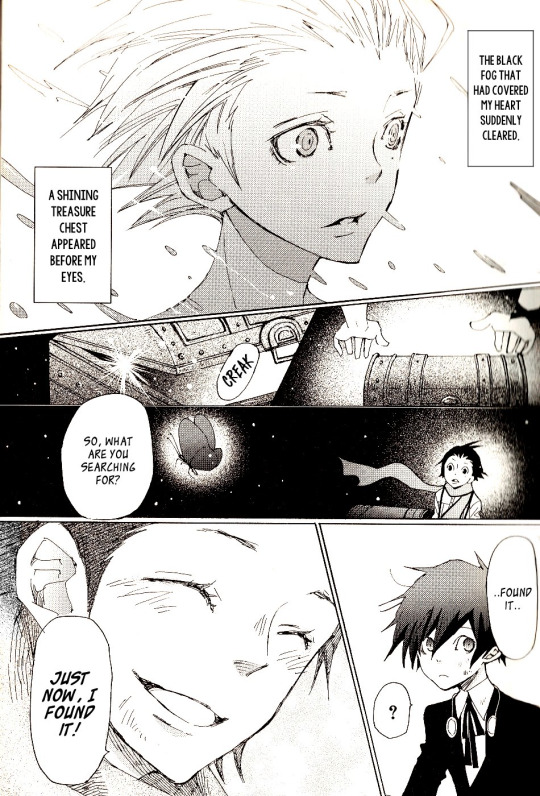
(While technically a non-canon portrayal of things, I still think it fits here :) After all, we know butterflies represent the souls of individuals in the series)
It’s not a perfect correlation naturally; the soul-image is that of the opposite gender of consciousness, to balance the psyche. But the mirror idea is the basis of their relationship, with Ryoji and the protagonist playing each other’s attitudes. The movies are more explicit with this, and there’s a particular quote I really hold close to my heart:
“綾時は理の対極にいるようなキャラクターです。物静かな理と社交的な綾時は"静と動"の関係であり,彼らの対比第3章の物語に欠かせない視点をもたらしています” - Keitaro Motonaga, Persona 3: Falling Down Pamphlet.
“Ryoji is a character that feels like the opposite of Makoto. The quiet Makoto and the sociable Ryoji have a relationship of ‘stillness and motion’, and their contrast brings about an indispensable perspective in the third chapter of this story.”
The connections are clear: Makoto is an introverted sensor (ISxx), and Ryoji is an extroverted intuitive (ENxx). And if we really break down their character, Makoto is an ISFJ (overall ISFx, with the J/P depending on the particular media) and Ryoji an ENFP, which is pretty damn close to a mirror match! You can compare them with Elizabeth, who is likely an ENTP.
Anyway, what’s more interesting in Ryoji’s Type is how it’s described on Psychological Types, under the “Extraverted Intuitive” section:
Going from object to object and situation to situation, never satisfied with the current circumstances staying the same.
That applies to people too, how they can go from adventure to adventure in search of romance.
Thanks to the enthusiasm they hold for what is next, they are able to inspire others as well.
Their unconsciousness is mainly governed by an archaic Sensation directed towards introversion, which means their blind spot corresponds to the endosomatic part of the senses, manifesting as strange and absurd sensations (which yes, it can include perceiving the world as dream-like).
And since Ryoji is a feeler as well, all those characteristics acquire a romantic tinge, seeing things by what they emotionally mean instead of what they (sensually) are. Does it sound familiar? Metaphors about flowing water maybe? You can quite literally do one of those school homeworks of joining columns with those points and Ryoji’s characterization.
Another interesting thing to consider is the contrastive relation between Ryoji’s and Makoto’s Types, which returns to my previous point of Ryoji being incubated through Makoto’s introversion, because he’s the personification of Makoto’s unconscious functions. The only exception is Ryoji being an extraverted feeler (ExFx) instead of an extraverted thinker (like with Elizabeth again, or Metis), but I still think it fits with Edogawa’s explanations in P4G:
“However, it's not impossible that you might have picked it. The other path was certainly a logical choice. Your Shadow is the path that you didn't take. In other words...It is another you. The Shadow is the ‘you that wasn't picked.’”
Through his fear and trauma, Makoto withheld all the “heat” he could have vested life with inside his soul, warming and breathing life into the seed that was sealed within him. But whereas the Shadow merely personifies that repressed libido and possibilities, Ryoji became human only through living them—he didn’t only embody Makoto’s repressed yearnings and sufferings, but made them his own. This returns once more to the jewel of Pandora that doesn’t solely belong to Prometheus (i.e., Makoto), but to the whole world.
“hell: a name for the *prima materia, the *black colour which appears during the *putrefaction of the matter of the Stone at the *nigredo, the torture through which the ‘body’ of the Stone passes while being dissolved by the secret fire. [...] The nigredo stage is also known as ‘Tartarus’. During the process of the nigredo the colour of the putrefaction is said to be as black as pitch, and the shades of hell appear. A profound blackness reigns both over the matter in the alembic and over the alchemist who may experience the torments of hell while witnessing the shadow or underworld of the psyche.” - A Dictionary of Alchemical Imagery, by Lyndy Abraham.
There’s no need to explain why Tartarus and the Dark Hour are the unconscious, but I’ve to in regards to how they represent Makoto’s “stagnant hell” and their relationship with alchemy.
Fire and Motion
According to the same book I quoted before, “A Dictionary of Alchemical Imagery”, towers in general can be interpreted to be symbols of the alchemical alembic, the main instrument through which the alchemists try to create the philosophers’ stone. However, alchemy is both an outer and inner discipline, so the tower isn’t merely a symbol for the external instrument, but also for the inner one: the human soul, which is put through hellish heat to purify it. Thus, towers, hell, and the individual become synonyms for the same alchemical instrument of transformation, fueled by the “secret” or “inner fire” that, in this case, corresponds to Makoto’s libido.
If we follow the normal alchemical process, then Death/Ryoji should be equal to the prima materia or the first matter used to create the Stone. But since the Stone is a symbol of the Self, the presence of Ryoji is iffy unless we, instead of thinking of him as the actual goal of alchemy, interpret him as the “secondary” goal, as gold itself, the mineralized/gross essence of the sun.
“But when the alchemists speak of gold they mean more than material gold. In the microcosmic-macrocosmic law of correspondences, gold is the metallic equivalent of the sun, the image of the sun buried in the earth. The sun in turn is the physical equivalent of the eternal spirit which lodges in the heart (the ‘sun’ of the human microcosm).” - A Dictionary of Alchemical Imagery.
This is a topic I already explained previously, since “sun = life = libido = phallus”, corresponding to the masculine/yang/extraverted side of things. As I previously noted on Nyx's post, one can see all of these connections through Ryoji’s infamous yellow scarf that represents the golden color—Nyx's core—of the final battle according to the Design Works (again, thanks to elle-p for pointing out that indecipherable text!), decidedly marking him as a product of Makoto’s inner work—as his “mineralized” life-energy.
But to describe Ryoji as purely gold would be incorrect; he’s far from being a pure manifestation of the incorruptible essence of the sun. His true nature is pointed by, again, the final Persona of his Linked Episodes, Saturn, the black sun.
“This power is called ‘sulphur.’ It is a hot, daemonic principle of life, having the closest affinities with the sun in the earth, the “central fire” or ‘ignis gehennalis’ (fire of hell). Hence there is also a Sol niger, a black sun, which coincides with the nigredo and putrefactio, the state of death.” - Mysterium Coniunctionis.
It’s darkness itself, the stagnation of life and its energy that leads to the state we see in the Dark Hour: putrid and rotten to the core, stagnated and filled to the brim with the dead and lost in life. It’s the collective “dark night of the soul”, the nigredo stage of alchemy of all humanity that can only be overcome by setting the world in fire, the element of motion and change that makes the clock advance with each full moon and each cleared floor in Tartarus, for better or worse. The transformation of Death into Ryoji is just the repetition of such a process at the individual level.
And if all of that sounds familiar, it should be! That’s the fundamental meaning of both the Fortune and Death arcanas, representing the nature of life as endlessly changing to represent its wholeness. Thus, life stagnating and “becoming a void” is a paradox that must be solved by reigniting its motion/change, lest it collapses into itself.
“This card is attributed to the letter Nun, which means a fish; the symbol of life beneath the waters; life travelling through the waters. [...] In alchemy, this card explains the idea of putrefaction, the technical name given by its adepts to the series of chemical changes which develops the final form of life from the original latent seed in the Orphic egg.” - Book of Thoth, by Aleister Crowley.
The Death arcana is that hellish fire that puts people under the most unbearable pain to put things in the correct path once more. Due to that, it has three “manifestations”: the scorpion that kills itself when finding itself surrounded by fire; the serpent that renews itself through its skin-shedding, crawling and thus still attached to earth; and the eagle, the spirit of life that soars the sky, unbounded by and embracing change at the same time. Yet, Death as a Shadow represents the contrary, the stagnated core of the Dark Hour that leads all to its destruction and that must be burned, killed, and resurrected
Alchemy is necessarily a violent process, for it requires the constant death and union of the elements so they can be perfected. In Death’s case, its alchemical work began from the moment it was separated/“killed” and sealed in Makoto, who is a stand-in for the maternal womb, the alchemical vessel, and the mercurial waters that dissolve the murdered element. Yet, as the alchemist himself, Makoto also pours his own life and heat into the dissolved Shadow to unify and resurrect it in a new, purer shape: Pharos, the creativity of a nascent sun, the seed of a new life.
(By that matter, Nyx crashing against earth follows a similar pattern: the original being is mutilated and “dissolved” through the alambic—the primordial hadean earth. The broken egg or core is an image that has the same meaning as the separation of Death; both fall under the dismemberment motif of alchemy)
But then, how does all of this relate with Saturn? Well, it’s because Saturn has a really long history in hermeticism, alchemy, and astrology: “he” represents the outermost and heaviest planet of all, embodying the limitations and structure of the universe such as time and death, devouring nature to rebirth it once again. Furthermore, the planet is associated with none other than lead, the heaviest metal that’s commonly used as a metaphor for the first matter, the moribund nature that… well, it should be obvious what one must do.

And funnily enough, just as fire is the element of transformation and renewal, Intuition in general corresponds to the function that oversees the dynamic elements of reality. It perceives the relations and motion between external/internal objects. So in more than one sense, Ryoji is the inner fire/spirit of Makoto. However, since alchemy deals with opposites and due to his nature as the black sun/saturn, there must be a limiting element in nature to restrain his ever-expanding/intuitive nature…
The Bonds of Death

Why a scarf? Why not another piece of cloth or even jewelry? Well, the image above answers why: a scarf is no different from a noose, one of the most common elements of death deities and grim reaper figures around the world, for what’s death but a hunter of humans? Thus, Ryoji’s scarf is a symbol of how even himself is bound to death, to his underlying nature.
“The difference seems to be due to the repression of real sensations. These make themselves felt when, for instance, the intuitive suddenly finds himself entangled with a highly unsuitable woman—or, in the case of a woman, with an unsuitable man—because these persons have stirred up the archaic sensations.” - Psychological Types.
I can hardly argue in favor of the “unsuitable” part, but there’s no need to really explain the other one, right? Déjà vu and all. That’s the “magical” part of Introverted Sensation, which transforms the sensed objects into symbols of the collective psyche through impressing it onto them. And in the case of inferior Sensation, as presented above, those filtered sensations become “effective entities” on their own right since the archetypal forces of the unconscious control them, possessing them even. This strengthens the idea of Ryoji’s attraction being rooted not only in the forgotten or unconscious memories of when he was Pharos, existing in a liminal state between consciousness and unconsciousness, but also points to how those memories are themselves mixed with archaic, mythological imagery, and that only has one source.
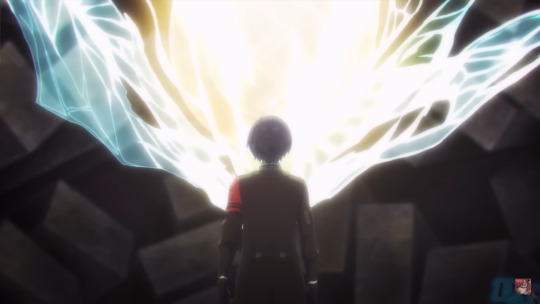
The protagonist is Ryoji’s alchemist and thus an equal to his mother, a reflection of Nyx as Death’s mother, the black ocean from which the transmuted golden egg (or seed) was extracted. This relationship is also pointed out by the fortune teller in club Escapade during January, explaining how “nothingness is the other face of the infinite world/universe”, ultimately hinting at the same thing I explained through the inferior Sensation: the oneness between the figure of Nyx and Makoto (understanding him as a symbol for all humanity).
In particular, I think the image above is perfect for this, since not only Nyx’s core and Makoto are (close to be) superimposed with each other, but also due to the black spiral in the background. The spiral also appears on the Great Seal’s surface, and within this context I have to quote Jung once more:
“We can hardly escape the feeling that the unconscious process moves spiral-wise round a centre, gradually getting closer, while the characteristics of the centre grow more and more distinct. Or perhaps we could put it the other way round and say that the centre—itself virtually unknowable—acts like a magnet on the disparate materials and processes of the unconscious and gradually captures them as in a crystal lattice. For this reason the centre is (in other cases) often pictured as a spider in its web (fig. 108), especially when the conscious attitude is still dominated by fear of unconscious processes.” - Psychology and Alchemy.
The book and even the own paragraph goes on to say that the “centre” is the Self (along with a noteworthy mention of the orphic egg again). But more importantly is the mention of the web here, representing consciousness’ fear of joining into the endless spiral that moves around without end, and its connection to the first kanji of Ryoji’s name: “綾” means “twill weave” or a “pattern of diagonal stripes”, a textile element that shouldn’t be so different from a web. Needless to say, all of that is connected to the figure of the alchemist/crafter and that of a mother.


The scarf in the first image, due to the fetal position of Ryoji, can be read as an umbilical (normally red) cord connecting him to Makoto/the mother, while the second is a little more explicit with the association to the red thread of fate—and what other fate there’s but death? Ryoji’s inherent connection to Death and Nyx is expressed through the “golden cord” that his scarf is, which can also be read as a noose, and as a manifestation of the inferior Sensation, the static element that eternally joins him to his source.

(Scan uploaded by Vesk)
Even the final resolution of Ryoji and Makoto, the white stone and pure dove incarnated, can’t abandon the chain that binds them to death and its hellish fire. However, this time is a willing acceptance of its existence, holding it with one’s hand instead of letting it strangle the individual unconsciously. Even the hands at the waist are holding each other gently, representing the final union of the “lovers” at the top of the alembic—at the top of Tartarus—in the form of a winged spirit.
“The united bodies of sulphur and argent vive, usually symbolized by a pair of lovers, are killed, dissolved and laid in a grave to putrefy during the stage known as the *nigredo. Their souls fly to the top of the alembic while the blackened *hermaphroditic body is sublimed, distilled and purified. When the body is cleansed to perfect whiteness it is then reunited with the soul (or united soul and spirit).” - A Dictionary of Alchemical Imagery.
Death is fate indeed, and in that fire, change and life. It’s the ultimate fetter that no one can go against, let alone the immortals that do not fear it.
#persona 3#persona 3 spoilers#ryoji mochizuki#makoto yuki#persona 3 protagonist#thematic analysis kinda?#there's a lot more I could comment here#specially in relation to his relationship with junpei since both of them are “red”#but I think this enough for the moment
38 notes
·
View notes
Note
What is t/a about?
ack, how exciting, i'm so glad you asked!!
thanatophobia, apeirophobia is the story i've been working on about a group of teenagers getting up to a variety of boarding school shenanigans ranging from amateur murder mystery detective work to osha noncompliant mycology & immunology, with a lot a lot of alexithymia and waxing poetic about the existential horror of it all!!
my main character is clive, an anxious little wet freak of a boy gratuitously mourning the semi-recent passing of his only friend and pet cat estelle. for some reason when he starts at boarding school, his polar opposite - a self-described "hedonistic romanticist" and ELA hobbyist with attention span and volume control issues - knocks on his dorm room door and decides on the spot that they are now best friends to be joined at the hip immediately. the poor boy is too awkward and polite to protest, and thus our protag duo is solidified.

(blonde whimsical one is juliet, four-eyes is clive!)
a lot of bullshit happens to these two pretty much as soon as school starts, including but definitely not limited to: a laissez-faire prefect hazing new students and tipping clive off to a violent crime scene (separate incidents), getting lost in the forest behind the school and discovering some kind of horizontal botanical pelagic zone system, being hunted down and warned of strange noises in the walls by a student who's not off his meds, why do you ask? and even a rare sighting or two of the seldom-seen headmaster who's presence (or lack thereof) is made all the more unnerving by the way the older students tend to refer to him by superstitious sobriquets.
oh, also, did i mention the mad science?
9 notes
·
View notes
Text
~~The Future~~
Summery: Tom Riddle seeks out oracle!reader, who is torn between instincts.
“The Gift was demanding, yes, but also notoriously and desperately attracted to dangerous people.”
Pairings: Tom Riddle x fem!Slytherin!reader
Notes: I plan to make this multiple parts! This will be the first series I’ve ever done so we’ll see how it goes 😵💫
Welcome to The Soul!

“Relax, Esme,” came Owler’s chronically unconcerned voice, along with an eye roll and a habitual tug on his green necktie. “We’re already late, might as well take our time.” To Owler, absolutely nothing warranted more than a leisurely stroll. And usually you would’ve agreed with him, if not for the circumstances of your lateness. “I doubt Professor Onai will think ‘jinxing Carmen Advile’s ex boyfriend’ is an adequate excuse.”
“So worth it,” he smirked, as you rubbed your temples. “Look, Owler, now you’ve given me a headache,” Not that it needed much, these days.
“Besides! I cannot be stuck with Lestrange again,” you lamented, the memories of last classes incident, (involving a crystal ball, a hover charm, and a goaded Peeves) all proved to be the last straw in your already thin patience and added to the present throb behind your eyes.
Divination would have easily been your most enjoyable class, if not for the fact that more often than not, you were sat next to a total dunce. You often wondered if Onai used your natural talent as a counterweight for everyone else’s fool. She had clocked you instantly as Lerrona Pythia’s eldest granddaughter— one of the greatest Seers of her time— and then immediately pronounced you Gifted in front of the whole class, to your dismay. The Gift was a personal thing, she should know. She seemed to be doing little to cultivate said Gift, however, because for the last two weeks, she’d assigned you to work with the mayor of Stupidville himself.
Probably the only other apt person in that class was Riddle, the perfect Slytherin Head Boy. Not that he would’ve even have any use or talent in the class; it was a feminine magic. He just seemed to excel at anything he touched.
Everyone seemed to either love him or hate him; public opinion being skewed overwhelmingly to the former.
You seemed to be the only exception to these polars. Yes, he was as handsome as everyone said, just as charming as well. Yet you’d seen those rare flickers of emotion in his shallow eyes and the flinches of his clique that followed. The Gift perked at the thought, shifting in you, welling that familiar curiosity and a rich sense of doom.
Those brief flashes of something other than the mask frightened those who knew to be afraid… Should you be afraid?
The Stirring was something your grandmother warned never to ignore, yet a tear in your instincts manifested. He was none of your business. None of your responsibility. So what if The Gift had a prophecy for him? Nothing you couldn’t ignore. Besides, there would never be a situation it could reveal itself. You’d never been alone in a room with Tom Riddle, and you didn’t plan on it. The Gift was demanding of course, but also notoriously and desperately attracted to dangerous people, it’s judgement occasionally bias.
Yes, that itch was best left unscratched, you decided.
“Onai sticks me with that asshat every chance she gets- Oh for god’s sake!” The already excessively long corridor leading to the Divination Stairwell was now literally stretching; new doors popping up to fill the spaces as the hallway horizontally expanded.
Owler only smirked at the castle’s show of unhelpfulness. “Screw Lestrange, we’ll make him move and I’ll sit with you.” You sighed, knowing Owler, that was probably an empty promise. The castle actively acting as an obstacle seemed to be the real thing that swayed you. Or rather, made you give up.
The trapdoor opened with a thunk, and almost comically, the small population of your fellow Slytherins along with a few scattered Gryffindors all turned their heads to the back of the classroom, where your head had popped up.
Professor Onai, now annoyed with the class’s stolen attention, pursed her lips and briskly ushered you and Owler up.
“Ms. Pythia, please take a seat with Mr. Lestrange, and Mr. Tisgrace please join Ms. Greenglass.” You wanted to curl up and die, but Owler only shrugged as he wandered toward the opposite side of the classroom. Despite your foul mood and the pang behind your eyes, the smell of oolong infiltrated your senses. You noticed with microscopic satisfaction, the tea sets present at every table. Tea leaves? He most likely won’t fuck this up.
As you made your way to your seat, Riddle caught your eye. Perfect as usual; neat curls, sharp jaw, shiny badge, and that damned blank expression that looked right up to meet you. His posture slightly straighter than normal, and he was twirling his pen. A habit you’d never noticed before. You inhaled and looked away, headache intensifying at the eye contact. Why does The Gift have to hurt?
After taking your spot across the dreaded boy, you sighed, deciding that he looked even stupider than usual today. He sat, casting somewhat dejected looks over your shoulder, directly to where his posse of Slytherin boys were sitting behind you.
It was none of your business if he’d gotten ruffed up or not; any wrongdoing to Lestrange was charity to everyone.
What exactly that little cult had going on was virtually invisible to the rest of the school, but being Slytherin yourself came with the occasional whisper of gossip. Riddle was obviously the ringleader of sorts, ordering around the other boys in his circle, while also successfully covering anything suspicious with his credibility. Not that anyone was suspicious about anything, really. Fellow Slytherins chose to turn blind eyes, and everything else flew under the radar.
“You may commence!” Onai declared, gaining her usual bravado back and interrupting your thoughts.
As if commanded to, Lestrange hastily poured your cup quicker than you could get to it, a drop sloshing over the rim and pooling on the saucer below- before glancing again at the table behind you. How unusual indeed. An unimpressed scoff is all he got from you as you took the cup.
Trying to be polite or under someone’s thumb? It was absolutely the latter, seeing as Lestrange had quite literally never done anything nice for another person before, especially not something so mundane as pouring tea. It was all you could do not to roll your eyes; judging by his out of character performance, the brat probably managed to fuck up somehow and was now on some sort of probation ordered by his gang. Serves him right, the little twat. You averted your keen eyes from him, opting to glance at him from over the lip of your cup every once and a while. You sipped away at the liquid, decidedly unconcerned by his dampened mood as you flipped languidly through the softened and worn pages of your mothers divination textbook.
“Page 117 has the key,” he spoke suddenly. You knew this of course, having memorized the entire thing by age 10. Your head shot up nonetheless, only to find him locked on the page presented. You were mildly surprised at his tone of voice… no… could it be? Timid? This was definitely out of the ordinary, and starting to peak your interest. You swallowed the last of the oolong, set your tea cup back on its saucer and cut to page 117.
~~~~~~~~~~
“Owler, wait!” You huffed indignantly at the end of the corridor. There he was in his lack of glory, talking up Advile on their way to the Great Hall.
He turned upon hearing your voice, spotted you, grinned like a madman, and promptly made a very inappropriate gesture in regards to Advile; standing clueless next to him.
All you could do was grimace and roll your eyes, irritatedly deciding it wasn’t worth it. You opted for the long route, leaving them be. Poor girl, you cringed at the idea of being in her place; Owler pawing after you.
You found him soon enough, conversing with Greenglass and Morestone in your usual spot at the Slytherin table.
You plopped your bag on the table, making Owler jump in surprise before he turned to you, that stupid smile on his face, satisfied by your last encounter.
“You make me sick, you know that?” You took your seat next to him and dug your fork into his pudding.
“Me and Carmen are in love, you wouldn’t understand,” he batted his eyelashes sarcastically, lacing his fingers together under his chin.
You scoffed, mouth full of pudding. “Poor girl, she deserves better, really.” That earned you a slightly too painful kick under the table.
“Hey! She likes me despite my faults, Esme!” He declared as you started to pile dinner onto your own plate. “That’s what real love is about!”
You were about to retort back, when something caught your eye at the opposite end of the table. Riddle and Lestrange, sitting together, both appearing to be concentrated on you. You met their eyes unafraid, who do they think they are? Lestrange immediately looked away, only confusing you more. He was exceptionally out of the ordinary today. He even read the leaves correctly and didn’t break the cup.
Riddle however was not one to look away- piercing brown irises trained on yours. It was you who broke away; suddenly your headache was back full force. You cringed and turned your head, eyebrows scrunched in concentration. In realization your stomach dropped. The Stirring was truly becoming unbearable… The Gift had a warning for him, and somehow he knew.
#tom marvolo riddle#tom riddle#tom riddle x y/n#tom riddle x reader#original character#slow burn#slytherin!reader
31 notes
·
View notes
Text
Motion Sickness
I've had the wonderful experience of sitting next to my sister on a plane, who never fails to bring her ginger ale back to light of day just as we land. It made me wonder why some people get nauseous in cars, planes, boats, etc. So, I'm going to explain how the vestibular system works, how it integrates with your ocular input, and why this makes some people feel sick.
The Vestibular System
This is the system within the inner ear consisting of the otolith organs (utricle and saccule) and the semicircular canals (there's three of those). It sits next to your cochlea within the inner ear, and the same cranial nerve (CN VIII) innervates both of them.
The semicircular canals detect the three planes of head rotation (yes, no, and ear to ear movements). The utricle senses movement in the horizontal plane, and the saccule senses it in the vertical plane (like the force of gravity). They each have these little plates of hair cells and some rocks on top of a gelatinous mass (it's true, look it up) that move to polarize or depolarize cells as their direction changes.
The Integration of Vestibular and Ocular Information
CN VII heads to the brainstem, where it enters through the pontomedullary junction. From there, it projects through the inferior cerebellar peduncle to the flocculonodular lobes of the cerebellum, or to the vestibular nuclei (of which there are four). From there, the information is used to determine head position, and make the appropriate neck, core, limb, and eye corrections to maintain balance.
Within the cerebellum, vestibulo-ocular information is organized and acted upon. You also get some positional information from your eyes. These systems are pretty well connected. Let's see what happens when they don't match up.
Motion Sickness
When you are in a car, your vestibular system can detect acceleration (same thing on a boat or plane), however, the objects in front of you aren't moving. This gives your brain two different signals, one that you are moving and one that you aren't. This is also why people with car sickness shouldn't try to read and should look out the window, it gives their eyes movement signals to send.
The opposite is true with people who get sick from VR head sets or video games. Their eyes are sending that they are moving, and their vestibular system senses no motion. This is confusing for the brain.
Why This Happens
There are a few theories, and some are more ass than others. I'll go from least stupid to most stupid. The one we learn in medical school is that the conflicting signals are just confusing for the brain, and this makes you feel sick. Simple as that. Your vestibular system can get used to constant velocity (and you can overcome seasickness if you became a sailor), so this answer isn't totally great. But it works.
There is also an anticipation component. That would be why a driver would experience less motion sickness than a passenger. In my mind, they're also usually looking ahead and seeing the car move, not fiddling with Spotify on their phone (hopefully) so that could be part of it too.
Another theory is that the sensations produced are similar to the feeling we get from toxic substances (which are detected by the area postrema, which makes us vomit), so our brain does the vomiting reflex again...the only sources I could find for this were an article from 1977 and a book on how to set up virtual realities from 2015, so I am not sure I like this one.
I don't know, mostly the cause of this is unknown and I'm not sure that anyone is really out there gunning for the answer to it. We can fix it and people can get over it, so there's probably better things to spend grant money on.
Treatment
Drugs.
Drugs work in the short term, and they are usually anticholinergic or antihistaminergic. The most common ones are scopolamine patches/pills, meclizine, dimenhydrinate, and promethazine. The one you'll probably buy at the store is Dimenhydrinate 50 mg.
If someone is working on a ship or a plane, they'll probably just get used to it. So there isn't any kind of long term treatment.
#medicine#med studyblr#medical school#med student#med school#vestibular system#ocular posting#technically
12 notes
·
View notes
Text
[Review] Wallace & Gromit in Project Zoo (GCN)
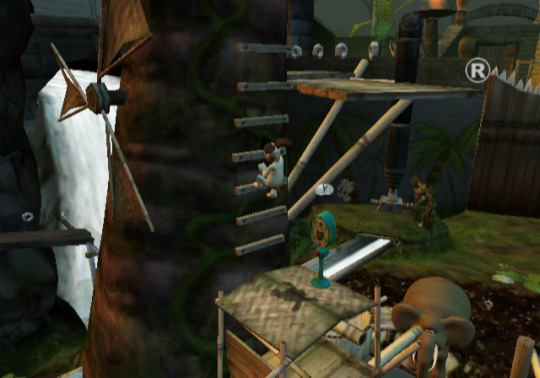
A pleasant day in.
I recently watched Aardman's new feature film, Vengeance Most Fowl, which is a follow-up to the plot of 1993's The Wrong Trousers, the second Wallace and Gromit short. But did you know that there was already a sequel in 2003, in the form of a video game by British studio Frontier Developments (mostly known for their theme park simulation games)? It's true! Anyway, I played it.
The plot is slight but makes for a decent W&G premise. The duo are visiting the zoo for the birthday of Archie the infant polar bear, who they have a connection to through the zoo's sponsorship program. But oh no! Feathers McGraw, the penguin criminal mastermind incarcerated at this selfsame zoo, has taken over and has enslaved the animals, including Archie, to further his schemes. As you make your way through the increasingly industrialised zoo enclosures (and secret underground mines), you must free the animals and ultimately foil Feathers.
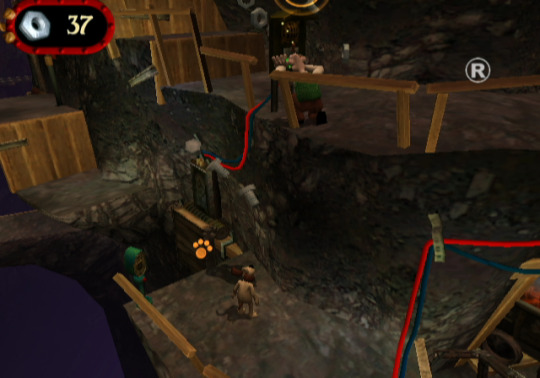
The game world has a nice cartoonish vibe that fits the tone of the claymation shorts, including the dark and shadowy parts. The characters and animation don't look particularly clay-like but they're on-model; the staff evidently invested a lot of polygon budget in making the major players nice and rounded, and the other animals are delightfully Aardman-esque. Along the way Wallace has plenty of amusing blather, voiced as always [until he retired] by Peter Sallis. Feathers has some fun mechs and machines that fill in as boss encounters, while basic enemy types are an assortment of animalistic robots, animal collaborators, and the occasional zookeeper (which are also revealed to be robots). What happened to the actual zookeepers is not explored.
The game plays out as a puzzle/exploration 3D platformer, with the player taking control of Gromit (ie. the competent one). Wallace follows along almost like Yorda in Ico; you can call him, and occasionally have to guard or guide him out of peril. He's needed to fix various contraptions to enable progress, although it's mostly just repairing panels to open doors. He does come up with weapons for Gromit at key points, silly G-rated things like a turnip launcher and porridge gatling. You also find a torch, fire extinguisher, etc. although oddly two slots on the weapon wheel are never filled and remain blank at the end of the game.

Apart from the weapons, Gromit has a surprising number of moves. A crouch jump, Mario 64-style side flip, a wall rebound thing that I never found a use for, as well as basic combat moves including a breakdancing spin kick. He can cling onto ledges which I always love to see. There's also a roll that gives you a bit more horizontal speed and chain into a long jump, but it's tricky to use effectively. There's not a huge call for this expansive moveset within the level design, though.
The levels vary in structure, which is interesting. The first world in the elephants' jungle enclosure is a set of three mini-hub style stages, like compact Banjo-Kazooie worlds with a lot of verticality. The mine, lava, and factory stages that follow are a bit more linear, although there is still plenty of branching and overlapping. The polar bears' icy zone was my favourite, an open and expansive playground. The game then ends with a very on-rails obstacle course, with lots of "save Archie from the timed hazards" going on. Between levels are boss fights and vehicle sections, some of which play out as rail shooters or an Asteroids-style fight against a submarine.

It's all impressively solid considering this is Frontier's first game of this type. And maybe I'm just projecting because they're British, but I got some Rare vibes from this game at times. From the BK-lite structure and Gromit's coin-nabbing celebration animations to a slightly Star Fox Adventures soundtrack, to minor things like the health bar mimicking Conker's Bad Fur Day's chocolate squares but with crackers, the DK64-style giant keyboard activity, and the boat-mounted turnip cannon having googly eyes for no reason. There's even a Donkey Kong homage with a barrel-throwing gorilla!
Otherwise there's some nice touches in here, like not having a life counter, widescreen support (not a guarantee in 2003), and the collectibles unlocking clips from The Wrong Trousers to view (as well as a short behind-the-scenes documentary). Sure the camera is janky but that's to be expected from games of this vintage. And because it's a 3D platformer from the early 2000s, there is of course a slide section. I think these were mandated by the government in this era. After this game, Frontier got brought back to do the tie-in game for Curse of the Were-Rabbit, but this one interested me more for its unique story and I wasn't disappointed. Like the Wallace & Gromit shorts and films themselves, it was a nice pleasant experience.
8 notes
·
View notes
Text
‘When sea turtle hatchlings emerge from their nests, they crawl away from the dark shapes of dune vegetation toward the brighter oceanic horizon. But lit roads and beach resorts can steer them in the wrong direction, where they are easily picked off by predators or squashed by vehicles.
In Florida alone, artificial lights kill baby turtles in the thousands every year. They’ve wandered into active baseball games and, more horrifyingly, abandoned beach fires. The caretaker of one property found hundreds of dead hatchlings piled beneath a single mercury-vapor lamp.
Artificial lights can also fatally attract insects and might be contributing to their alarming global declines. A single streetlamp can lure moths from 25 yards away, and a well-lit road might as well be a prison. Many of the insects that gather around streetlamps will likely be eaten or dead from exhaustion by sunrise. Those that zoom toward vehicle headlights probably won’t last that long. The consequences of these losses can ripple across ecosystems and into the day.
In 2014, as part of an experiment, ecologist Eva Knop installed streetlamps in seven Swiss meadows. After sunset, she then prowled these fields with night-vision goggles, peering into flowers to search for moths and other pollinators. By comparing these sites to others that had been kept dark, Knop showed that the illuminated flowers received 62 percent fewer visits from pollinating insects. One plant produced 13 percent less fruit even though it was also visited by a day shift of bees and butterflies.
It's not just the presence of light that matters but also its nature. Insects with aquatic larvae like mayflies and dragonflies will fruitlessly lay their eggs on wet roads, windows, and car roofs, because these reflect horizontally polarized light in the same way as bodies of water. Flickering lightbulbs can cause headaches and other neurological problems in humans, even though our eyes are usually too slow to detect these changes; what, then, would they do to animals with faster vision, like insects and small birds?’
-Ed Yong, An Immense World
34 notes
·
View notes
Text
Prismatic
"Kid."
"What's wrong."
"Help me out. What's this with the Light-Dark shit. Line is thin but it's good steel."
"... Sure. Meet me in the Pale Heart? Landing zone is fine."
"'kay."
~
Three expected a shit-eating grin, but instead the Titan looked more like she'd been caught doing something she wasn't supposed to.
"What's the," Three gestured vaguely at her entire person, "about?"
She tried to stand up straight and failed. "Well. I don't really like it. And it always feels kinda awkward because I feel like I'm supposed to, you know? Whole big, grander than the rest gifts from the Traveler, blah. And I... Really just do not like it." She shrugged. "Fire is home, and I have to leave the warm parts to reach the Dark. Everything I like about Strand is too far away when I'm holding onto the Light. It's just not great. So it's embarrassing."
Three could hardly believe it.
"Thomas has really liked it," she said, and the Warlock emerged from his hiding place and waved. A cute little prank. Three only just didn't roll her eyes, half-sure it was Thomas's idea.
But then Freija put on her helmet and turned away. "So he's gonna help, and I'm gonna go play with the Hive and maybe clear a chunk and meditate." She sprinted off the balcony with no further ado, leaving her roommates to talk.
Thomas chuckled at Three, who couldn't peel her red eyes off him. "You're actually better at it than her?"
He grinned. "Sort of. She's better attuned, but I'm far better at using it and I'm learning a lot." He beckoned down the stairs to the room where Micah's communication table sat.
The cracks in the ground didn't feel like cracks. They looked like they should feel like something but the only texture was the roots of the tree. The pink 'hole' was as flat as the rest of the floor.
"Sit," said Thomas, perching on one of the roots. "Meditate, you know the drill."
She did. She never sat "right" for it, finding it easier to relax if she was leaning on something. In this case a tree root high enough to prop a shoulder and her chin on. One leg folded under and the other crooked next to her chest.
In she went. Swimming up, out of the void, into the Light. Only she didn't have her Darkness in here at all. Getting to her Darkness was another process.
And it wasn't gradual. The moment she decided to meditate for Stasis or Strand, she was in the same non-space with the two types and no Light, where she could choose one. If she tried to return to the Light, she would meet the Void again.
"Neat. You just popped over like you weren't Light-aligned at all."
"I can only pop over. Stasis suited me instantly."
Thomas chuckled. "I did the same thing with Strand. So, look around for the wall. The Line. Where's your Light types?"
"Up, down, and left," she replied. "Big empty space. Stasis and strand stand next to each other, forty-five degree arc. Light empty space takes work to get to."
"Try superimposing the view on each other? Like maybe next to the sideways one? Rotate the Light to horizontal and line up all five together? What order would that go in?"
"Left to right, Void, Stasis, Solar, Strand, and Arc."
"What happens when you try to touch both Void and Stasis at once?"
"Let's see."
The empty space was empty, and the Powers changed size relative to her proximity. At their smallest, they looked like they could be bowling balls, but right before stepping in, they were an entire world. The closer she got, the bigger the closest became and the smaller the furthest shrank.
So stepping to the halfway point between Void and Stasis created a sharp line between, with the hollow blackness on one side and the empty white on the other. (Everyone else called it blue, but Three knew Stasis as the translucent "white" of Polar Bear fur, a beast extinct since her death and rebirth.)
"I don't know why I didn't expect a literal dividing line," Three observed aloud. A hairline seam between the two vaccuums held Light and Dark apart.
She lifted her blue hand...
...and pinched the thread...
...and pulled.
She expected gray, as black and white would make, but instead the hollow white became a crystal shell over the universe, glowing and glittering, and the power washed over her, setting a calming chill over her heart.
She stepped closer and let herself drift into nothing, getting lost in the dancing crystalline stars.
"There you go," Thomas cheered. Three knew he said it but couldn't be bothered with responding.
It was so beautiful.
~
For Destinytober
Home story List here
Complete story list Here
16 notes
·
View notes
Text
Sutviprra Update and Addendum
I have reconsidered some parameters, and some were present in an early version but not stated clearly enough.
First of all - previous versions of trunks would need a lot of resources to sustain and no evolutionary pressure would make such a hypertrophy. I still don’t completely delete such length - if the allele that made current trunks happens, Sutviprra will get abnormally long trunks, but do they stay alive and pass them down - question to their environment. Norm, from now on is such. Sutviprra ancestors lived on the jungle river shores, and lengthened lips allowed them to forage from the bottom, catch fish and, potentially, stand up and reach a low branch with a fruit. As the jungles receded, they also started scavenging, and this is where tool use and sapience development really started.

Tentacle apparatus is not as massive, but still, this adaptation disrupts previous muscle connections. Sutviprra belong to phylum Tetragnata - “four jawed”. In their class, jaws are capable of both vertical and horizontal motion and upper jaws serve radula-like grate function, grinding down food. In Sutviprra, trunks took up so much muscle attachment, movement of radula became restricted. At first, lower jaws complemented the function, developing an incisor-like section for cutting the food items and improving a tongue to move the food under the radula. With diversification of the diet, chewing apparatus alone stopped being sufficient, but this is what incited a pressure to develop pre-ingestion processing, so tool use and fire.
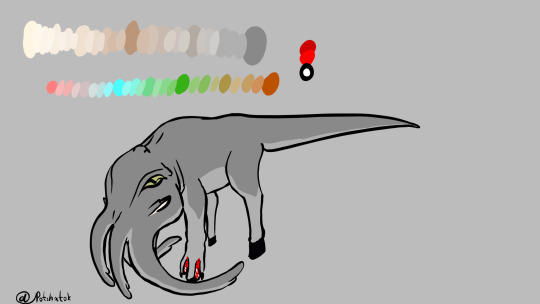
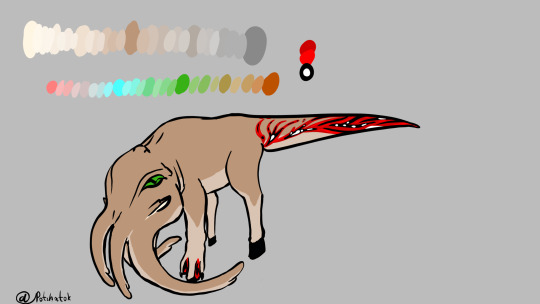
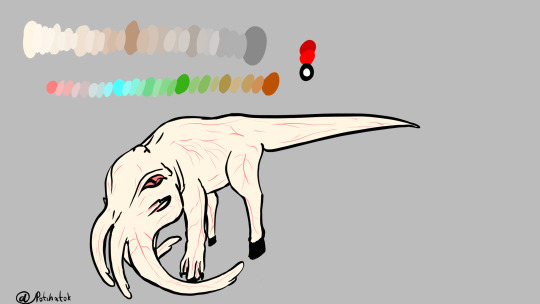
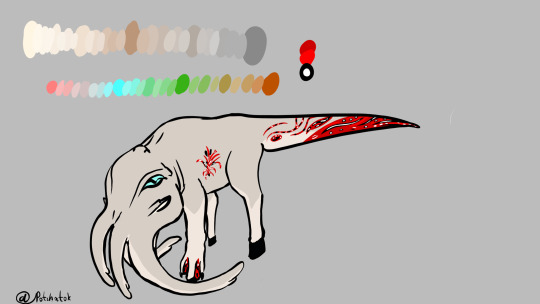
Their class, Cryptotheria, arose in a frigid polar environment, so at first all their adaptations all work to preserve energy and heat. Previously continuously hermaphroditic, In this condition producing redundant organs is not worth the energy, and, given the population density, sequential hermaphroditism becomes a norm. Most of such creatures are born male and depending on their condition become female later in life. As the conditions change, the race for populating new niches has begun, while conditions stayed rather rough - boreal forests are the warmest regions available. Many creatures evolve some sort of childcare, as this improves their chances. Proximapters already had ovoviviparity nesting and nest guarding behaviors, while Cryptotheria diversified with different strategies. Marsupacrescentia just rely on long gestation, when the embryo can be atrophied or put in a hibernation depending on resources of availability, while Mellacrescensia adopt altricial young, but their scent glands mutate to secret a gel, that helps the young to develop to a proper degree. This allows them to fill in niches of smaller animals, both sanitary and migratory. One of such offshutes, a medium-sized omnivore, reaches Oujsoerian jungles, diversifying there into the Tropicasussa. Such creatures lose their fur, have long gestation periods and a high intelligence. Living on the river coasts, Tropicasussa encounter pressures that kick them into the Sutviprra path. Energy efficiently of Cryptotheria allows them to achieve such brain functions, Mellacrescensia’s high requirement for parental care establishes fundamentals for learning from the adults, Tropicasussa’s opportunism allows for a wide variety of energy sources and a big range of behaviors - smartness. Of course, there were different species of sophont Tropicasussa, and Sutviprra represent hybridisation of some of those, that ended up colonizing the continent.

#sutviprra#art#speculative biology#worldbuilding#spec bio#alien design#exobiology#spec evo#speculative evolution#digital art
16 notes
·
View notes
Text

Pseudo-3D cubes technique could alter our understanding of cosmic structures, central black holes of galaxies
Researchers at the University of Minnesota Twin Cities College of Science and Engineering have developed a new technique that reconstructs two dimensional (2D) radio images–visual representations created from radio waves–into three dimensional (3D) "Pseudo-3D cubes" to help better understand objects in the universe.
The work is published in the journal Monthly Notices of the Royal Astronomical Society.
Traditionally, when radio images are captured in a 2D format, the images may not allow scientists to infer what the object looks like in 3D. Transforming these images into a 3D space can help better understand the physics of galaxies, massive black holes, jet structures, and, ultimately, how the universe works.
The researchers looked at polarized (radio) light—light that vibrates in a specific direction. We experience polarized light when we look at the glare from sunlight off a highway—it vibrates horizontally. We then use polarized sunglasses that allow only vertical vibrating light to pass and the glare disappears.
The research team made use of an effect called Faraday rotation, which rotates the direction of the radio polarized waves, depending on how much material they have passed through. With this, they could estimate how far each piece of the radio picture had traveled, and thus create a 3D model of these phenomena happening millions of light-years away.
"We found that the shapes of the objects were very different from the impression that we got by just looking at them in a 2D space," said Lawrence Rudnick, a Professor Emeritus in the University of Minnesota School of Physics and Astronomy.
With this new technique, the researchers were also able to determine the direction of material expelled from massive black holes, look at how the material interacts with cosmic winds or other space weather, and analyze the structures of magnetic fields in space.
"Our technique has dramatically altered our understanding of these exotic objects. We may need to reconsider previous models on the physics of how these things work," Rudnick added. "There is no question in my mind that we will end up with lots of surprises in the future that some objects will not look like we thought in 2D."
Previous imagery will need to be reanalyzed using this new technique to confirm previous thoughts or bring new insights. Rudnick hopes to see this technique applied to imagery being taken in new telescope facilities around the world.
In addition to Rudnick, the team included Craig Anderson from the Research School of Astronomy and Astrophysics at Australian National University; William Cotton from the National Radio Astronomy Observatory; Alice Pasetto from the Institute for Radio Astronomy and Astrophysics National Autonomous at the University of Mexico; Emma Alexander from the Jodrell Bank Center for Astrophysics at the University of Manchester; and Mehrnoosh Tahani from Kavli Institute for Particle Astrophysics and Cosmology at Stanford University.
Data for this project came from the MeerKAT radio telescope array, a facility of the South African Radio Astronomy Observatory.
IMAGE: Researchers used a new technique to transform 2D radio images into a 3D model to better understand phenomena in our universe. Credit: Lawrence Rudnick/MeerKAT Radio Telescope
youtube
3 notes
·
View notes
Text
Originally posted to Facebook, and unaltered from that text:
----------
The 2022 Nobel Prize in Physics was awarded for what is commonly regarded as "confirmation of quantum physics" but this is muddleheaded nonsense. What it actually was awarded for is what is considered by physicists proof that no mathematics except quantum mechanics can derive the correlation coefficient of the following experiment. You have to have a clear head to see that this is the actual claim, but it assuredly and inarguably is.
Here is the experiment, and I will derive its correlation without using quantum mechanics. I am not sure anyone knew how to do this before I did, and it took me about 20 years to find.
A light source emits two photons left and right, randomly with one polarized vertically and the other horizontally. Each photon goes through a polarizing beam splitter, whose two output channels +1 and -1 are finished by photodetectors. The left PBS has angle a', the right PBS has angle b'.
There is a law of physics called the Law of Malus, where the accent is on the u in Malus. When applied to a horizontal photon in a polarizing beam splitter with angle a', it says the photon will go through the +1 channel with probability cos² a', the -1 channel with probability sin² a'. Similarly if the angle is b'. If the photon is vertical, the cos and sin are reversed. (I am leaving out all other possible angles. The full Law also accounts for them.)
This is not the traditional statement of the Law of Malus, but is what we want. When you are using quantum mechanics, the rules are written funky and probably are not called the Law of Malus, but are an obfuscated way of saying what we just said.
By a lot of tedious but routine probability theory that I will skip here, but which you can find for instance in my "How to Entangle Craytons" at https://crudfactory.com, you get that the probability of +1 detection on both sides is the same as the probability of -1 detection on both sides, and equals (1/2) sin² a' cos² b' + (1/2) cos² a' sin² b'. The probability of of +1 detection on only one side is (1/2) sin² a' sin² b' + (1/2) cos² a' cos² b'. Call the probabilities in obvious ways P++, P--, P+-, P-+. Then I can get the correlation as follows:
corr = (+1)(+1)(P++) + (-1)(-1)(P--) + (+1)(-1)(P+-) + (-1)(+1)(P-+)
= -cos 2a' cos 2b'
where I have used a double angle identity you can find in the Handbook of Mathematical Sciences, etc.
Here is where I do something that has evaded the mental capacities of Nobel Prize winning physicists.
Let it be noted that we already know that the supposedly "quantum" correlation for an experiment with PBS angles a and b is -cos 2(a - b). One thing I have never seen physicists point out about this expression, despite the bleeding obviousness once pointed out, is its invariance under in-unison rotation of the angles a and b. What this means is that you can ALWAYS rotate the problem so that one of the angles is zero, without changing the result.
This is simple mathematics. But physicists are not taught actual mathematics. They are taught a kind of pseudo-mathematics not based on theorems, proofs, or thorough reasoning.
Let us set b' = 0 and let a' = a - b, for any PBS angles a and b. In other words, we simply rotate the problem by -b to convert it to an already-solved problem for a' = anything, b' = 0. We have thus derived the correlation, without using quantum mechanics:
corr = -cos 2(a - b)
The 2022 Nobel Prize in Physics is a load of hogwash. There is no such thing as "particle entanglement", there is no such thing as "quantum non-locality", there is no "confirmation of quantum physics", and there is no such thing as a "quantum" computer.
But I have more general proofs of the matter than that, which do not even require mathematical expressions.
What I have done here is show with that Einstein was wrong that statistical mechanics was what underlay the type of experiment described. It is actually just ordinary pinball-like mechanics! Einstein never wavered in believing there was no distinct "quantum" physics, and was ostracized for it. But he was right.
But I have gone beyond that and come up with meta-mathematical arguments that are of different kind entirely. Those are for a separate rage.
A late postscript:
This derivation may be a little confusing, because why does b' have to be set to zero? Clauser inequalities treat b' as nonzero, but obviously, from the derivation above, this is wrong.
Here is an explanation—
If you do NOT set b' to zero, how can you distinguish which particle each angle apples to? You cannot. You are actually solving the wrong problem.
This is what Clauser inequalities do—they solve the wrong problem.
With b' set to zero and symmetry of cos, we solve the right problem.
Really it would be better to note the difficulty at the beginning and set b' to zero right away. Going through the motions above, however, helps illustrate where physicists err by NOT setting b' to zero, when they try to derive "classical" solutions and get incorrect results.
(That their results were incorrect should have been obvious, because any result different from that of quantum mechanics MUST have been derived incorrectly. All math methods must reach the same conclusion, or math is inconsistent. But that is for another rage.)
1 note
·
View note
Text
[E. How are the essential directions of Existenz, which form the anthropological structures of its entire history, constituted? - cont'd]
[1. The first thing to note is that the three polarities we have described (epic, lyric, tragic), even though each has its independent status, one at least appears more fundamental - cont'd]
b. What is the anthropological privilege of this vertical dimension? Most of all, it brings out, almost nakedly, the structures of temporality.
i. Horizontal opposition of the near and the far [of epic expression] exhibits time only in the chronology of spatial progression. Time unfolds only between
a point of departure
a point of arrival
and is wholly exhausted in the journeying: and when it renews itself, it does so in the form of repetition:
return
another departure
In this existential direction, time is in as essence nostalgic. It tries
to close around itself
to recommence by linking up again to its beginning
The time of the epic is circular or reiterative.
ii. In the opposition of the light and the dark [of lyric expression], too, time is not authentic temporality, but
a rhythmic time marked by oscillations
a seasonal time where absence is always a pledge of return, and death, the pledge of resurrection
iii. With the movement of ascent and fall [of tragic expression], on the contrary, one can grasp temporality in its primitive meaning.
– Michel Foucault, Dream, Imagination and Existence: An Introduction to Ludwig Binswanger's Le rêve et l'existence (part IV: Ce qui pèse to l'homme, c'est le rêve [What weighs on man is the dream] — Bernanos), 1954, translated by Forrest Williams
1 note
·
View note